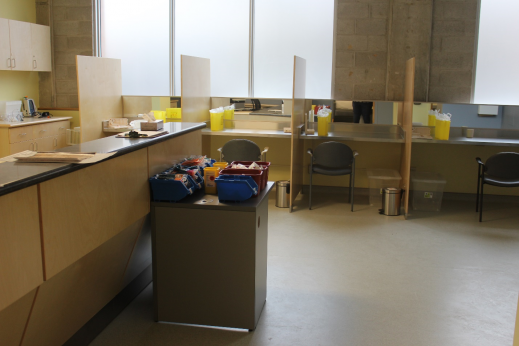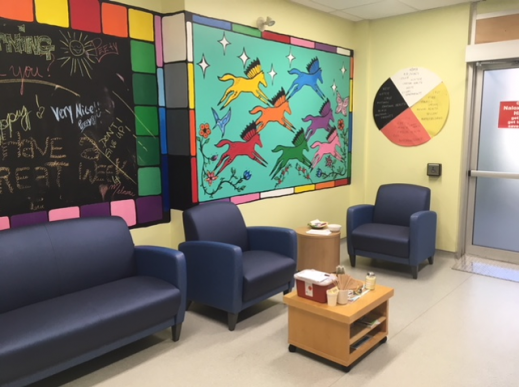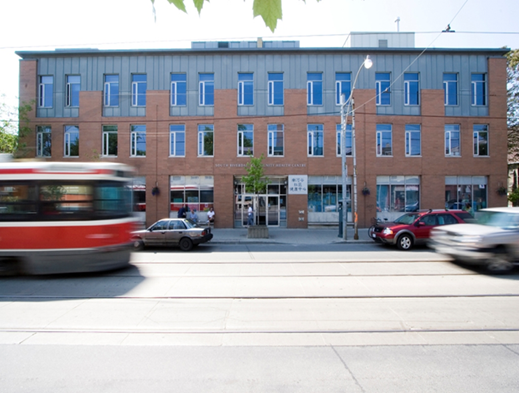What is the Program?

keepSIX is a supervised consumption service (SCS) in Toronto, located at the South Riverdale Community Health Centre (SRCHC). keepSIX is staffed by a multidisciplinary team including registered nurses, health promoters and harm reduction workers. It is part of a multi-service, multidisciplinary community health centre and is an extension of the COUNTERfit Harm Reduction Program, which offers a variety of harm reduction services.
keepSIX is a health service where people inject, snort or orally consume pre-obtained drugs in a safe, hygienic environment under the supervision of trained staff. This helps individuals to use drugs safely and securely without the fear of arrest or accidental overdose. The program also provides other services including primary care, education, counselling and health promotion. In addition, it refers people to drug treatment or other health and social services, as needed. Supervised consumption services can reduce the risk of transmitting blood-borne diseases, including HIV and hepatitis C, through use of safe, sterile injection supplies.
Why Was the Program Developed?
More than 9,000 people have died from accidental overdoses in Canada since January 2016 — 2,000 of them in the first half of 2018 alone, according to the Public Health Agency of Canada. In their community, SRCHC have seen rising overdoses and overdose deaths in recent years. In a 2014 study, SRCHC found that one in 10 of their harm reduction clients had experienced an overdose in the past six months. In 2017, they distributed over 5,000 naloxone kits.
Canadian and international evidence shows that SCS save lives and improve health. Research also shows that SCS are cost effective and do not increase drug use and crime in the surrounding area.
SRCHC planned and gathered input on a potential SCS for many years. This included consultations with staff, board members, people who use drugs, potential service users and organizational partners. They also did extensive community consultations with local residents, businesses, schools and other community groups, with a majority seeing the benefit of an SCS. A community liaison committee with broad stakeholder representation was created to ensure ongoing communication and engagement with the local community. keepSIX also has a community advisory committee made up of keepSIX service users and other community members who use drugs.
In 2016, the Toronto City Council approved three agencies to add permanent SCS facilities to existing harm reduction services. SRCHC’s service opened on November 27, 2018, after the organization submitted a proposal and got permission from Health Canada to operate under exemption from the Controlled Drugs and Substances Act.
How Does the Program Work?
keepSIX occupies a space on the first floor of the SRCHC, adjacent to the long-standing harm-reduction drop-in office. The service is open on weekdays from 9:30 am to 5:00 pm, with extended evening hours until 8pm on three days. The SCS consists of an intake area, a consumption room and a post-consumption observation (or “chill”) room. The space was designed to reduce stress by being welcoming and inclusive. A large mural on the wall of the post-consumption space was designed and created with service user input and incorporates LGBTQ2SIA and Indigenous imagery.

The keepSIX safe consumption room.
When they arrive, service users undergo a brief intake assessment process. First-time service users are asked to register and are given an orientation to the service. Service users can access the service anonymously or can use a confidential unique identifier code.
After intake, service users enter the supervised consumption room. The consumption room has three standard booths and one large booth (to accommodate a mobility device and/or more than one person), each with a chair, table, disposal bins and sharps containers. Staff are on hand to provide harm reduction supplies and education, training on safer injection techniques and strategies and more. In the event of an overdose, staff respond using oxygen and stimulation, or naloxone if needed.
After using, service users are encouraged to stay in the post-consumption or “chill” room. This provides a safe, comfortable space where individuals can stay after using and also an opportunity for SCS staff to continue to provide a variety of services and supports. These include:
- substance use and mental health support; informal counselling
- education and health promotion (on a variety of topics, including hygiene and nutrition)
- primary care including wound and foot care
- referrals and access to other programs and services (i.e., social workers, housing workers, hepatitis C treatment, opioid substitution services, detox and drug treatment)
- Indigenous cultural practices and supports

A large mural on the wall of the post-consumption space was designed with service users and incorporates LGBTQ2SIA and Indigenous imagery.
keepSIX is part of a multi-service, multidisciplinary community health centre. This means that many referrals can be made onsite, and in many cases, an individual can be seen immediately by a service provider. Service users have direct access to all of SRCHC’s onsite programs and services (e.g., healthcare, chiropody, seniors programs, midwifery) and established pathways to external services (e.g., treatment, hospitals, legal services, housing).
keepSIX is an extension of the COUNTERfit Harm Reduction Program, which for the last 20 years has offered:
- harm reduction supplies
- group programs (including women’s drop-ins and group programs like art making and cooking)
- mobile services
- satellite distribution locations in the community
- community clean-up and needle patrol
- education and workshops
- memorial services
Required Resources
The keepSIX SCS is a permanent facility housed on the street level at the SRCHC. The space was renovated for the service; this work included the installation of a specialized ventilation system to absorb any fumes generated when service users prepare drugs for injection in the consumption room. It is staffed by health promoters, registered nurses and harm reduction workers, as follows:
- Health promoters: (two full-time staff)
Health promoters have a variety of experiential or educational backgrounds. Their role is to address service gaps and needs via programs and groups (e.g., prisoner support, Indigenous sharing circles), ensure that keepSIX’s services are responding to the needs of its clients and coordinate outreach/community engagement activities (e.g. shelter in-reach). - Registered nurses: (two full-time staff)
Nurses provide all clinical services (e.g., first aid, wound care). They administer primary care and proactive/preventive interventions (e.g., hepatitis C testing, screening for HIV and other sexually transmitted and blood-borne infections, flu shots) and oversee biohazard management. - Harm reduction workers: (two full-time equivalents)
Harm reduction workers have lived experience of drug use. They provide client care and identify barriers and gaps in services. They share expertise (including consumption techniques) and overdose prevention strategies, provide treatment and drug information.
With the exception of clinical care, most of the responsibilities of these positions are shared, including intake/assessments, harm reduction education, counselling and referrals to other internal or external services. All keepSIX staff are responsible for ensuring appropriate client flow within the service, for safe disposal of substances and injection equipment and for responding to overdoses or other crises.
Opening the service was a complex and lengthy process that involved working with the local community and the local, provincial and federal governments. To operate an SCS in Canada, you must apply for an exemption from the Controlled Drugs and Substances Act. There are also requirements at the provincial or territorial level, which vary.
Challenges
- Social services may be over-capacity for referrals
One of the challenges the team faces is that external services/agencies may not have the capacity to provide the requested services for keepSIX’s users. For instance, shelter, housing and drug treatment programs are difficult to access. - Longer intake process for service users
Compared with temporary overdose prevention sites, SCS has a lengthier process for registration, intake and assessment. This can be perceived as invasive and onerous both by staff and by service users who access both models. keepSIX staff learned the importance of distinguishing between overdose prevention sites and SCS, being transparent and explaining the Health Canada exemption requirements. - Destigmatizing drug use and understanding the SCS as a harm reduction and healthcare service
For service users, using drugs in front of staff (and strangers) is intimidating and requires a leap of faith. Time is needed to establish service user trust, both to use the SCS and to engage in additional wraparound services. - Limitations around assistance with injection
keepSIX has been part of a pilot study to allow service users who have difficulty with self-injection to receive assistance from a peer. As per Health Canada’s exemption regulations, SCS staff are not currently allowed to assist, which creates problems for service users who do not have someone they trust to help them in this way.
Evaluation
Between November 2016 and September 2018:
- There were 1,803 visits to keepSIX (average of 197 per month), by 342 unique service users. These numbers have gradually increased, from only 35 visits in the first full month of operation to 299 in August 2018.
- Of all of the visits, 64% were by male service users and 33% were by female service users; 3% of visits were by people identified as “other” or not identified, and fewer than 1% were by people identified as trans.
Drugs and overdoses:
- There were 2,225 total drug consumptions, with more than 75% being opioids (fentanyl, heroin, morphine).
- There have only been 7 overdoses in this time, all of which were reversed by keepSIX staff, without the need to engage emergency medical services.
Other services and referrals:
- The most common supportive services delivered at keepSIX were:
- harm reduction/safer use education
- support or counselling
- first aid or primary care
- The most common client referrals were to:
- social services (e.g., housing)
- internal primary care or clinical services at SRCHC
- hospital
A large-scale, formal evaluation is underway at the time of writing. Informal client feedback has been consistently positive, with many users noting they feel safe, comfortable and supported. There is a high rate of return for service users, good uptake of other services and a low rate of overdoses.
Lessons Learned
- Feedback from service users should be proactively incorporated
This helps to address gaps or unanticipated needs for service delivery (i.e., foot care, grief support). Intake assessments and real-time interaction have afforded staff greater opportunities to understand the local drug supply and shifts and trends in supply and use, and to adapt services to respond to client needs. Flexibility, adaptability, humility and responsiveness to people who use drugs and changes in drug trends need to be intrinsic to an SCS. - People with lived experience should be meaningfully engaged
This includes experience of drug use, criminalization, overdose, poverty, homelessness, among other issues. This is integral to building trust among service users, doing outreach in drug-using networks and promoting services through other programs and agencies. - Community partnerships should be built
While community consultation can be onerous, partnerships with key community partners are very beneficial. This has allowed keepSIX to establish allies throughout the community who have high levels of knowledge about SCS. This also allows them to responsively address and alleviate concerns in the community and leverage relationships that benefit the service and service users. - Grief and loss need to inform service delivery
The overdose crisis has had a significant impact on the community. keepSIX offers sharing circles and is increasing its capacity to provide grief and loss support. SRCHC leadership also offers staff services and supports to deal with trauma specific to their work and increase resiliency. - There is a need for culturally appropriate harm reduction services
A large proportion of keepSIX service users are from racialized communities, in particular from Indigenous communities. It is important to have staff who reflect the diversity of service users to provide safety and offer culturally specific understanding and support.
Contact Information
Julia Barnett, Manager, Urban Health Team
South Riverdale Community Health Centre
955 Queen St. E.
Toronto, Ontario
M4M 3P3
Email: jbarnett@srchc.ca

